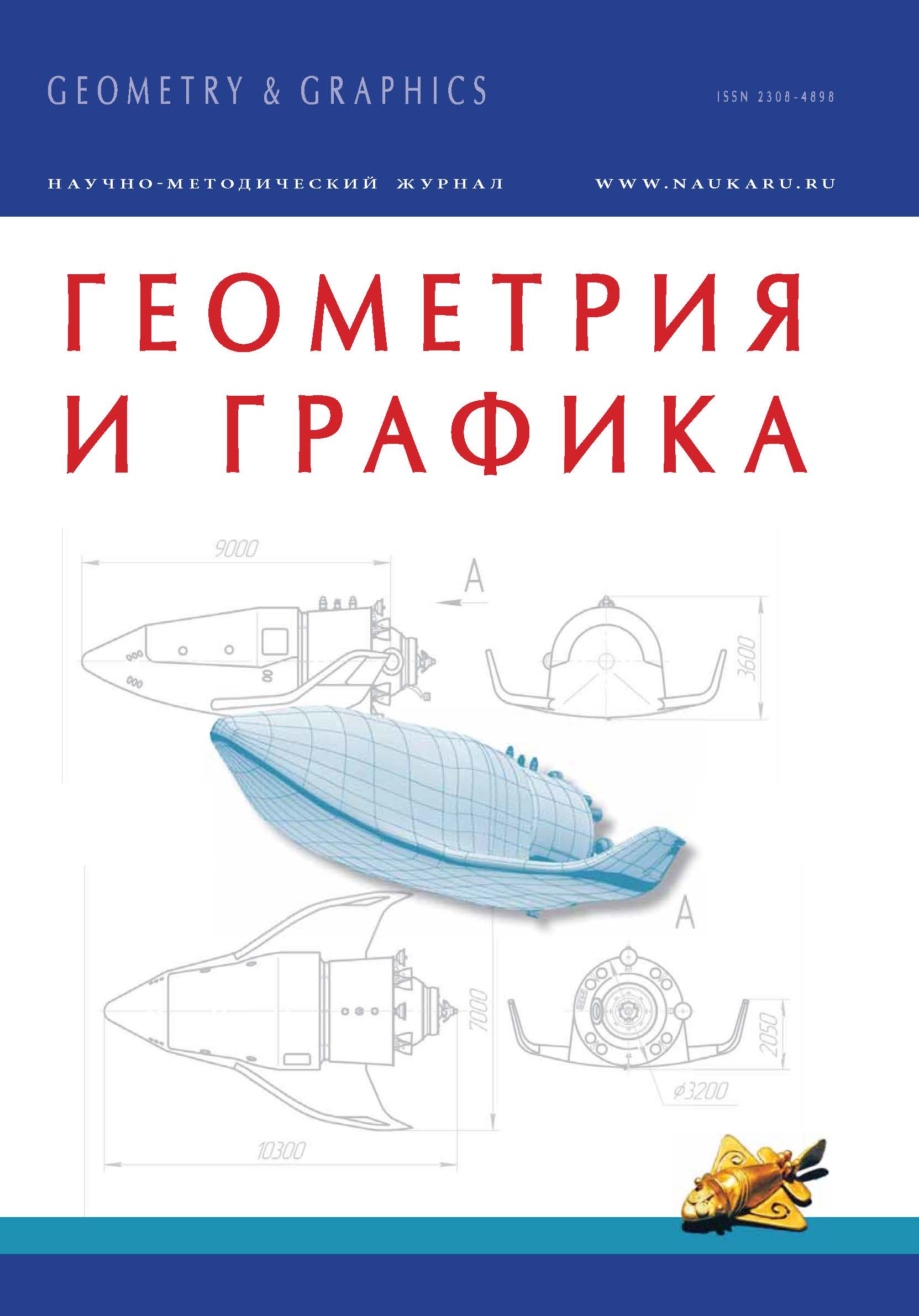Ekaterinburg, Russian Federation
Ekaterinburg, Russian Federation
Descriptive geometry, whose subject of study is three-dimensional real and imaginary objects, is available for a specific method both of knowledge deepening and gained knowledge control. Thus apart from visualization of graphic constructions is available a strictly logical sequence of their execution. Using a graphical editor instead of a ruler and compass not only and not so much facilitates routine operations for construction of circles, parallel and perpendicular lines, but allows literally touch geometric images. Choice of one of three methods such as construction, transformation or intermediaries ones, allows a student under testing not only to respond a specific question, but also to choose a more suitable way to solve this problem. Has been presented the description of computer program that allows quickly solve course problems with the prompt, if necessary. Other modes make it possible to exercise self-control or final control of gained knowledge. The program interface is multi-window structure enabling in sequence, on proposed 4–7 steps, solve a problem in the animation mode. A program feature is the absence of false (harmful for the study) questions as options. The right questions of another stage are used as alternative. When the answer to the question is wrong, than the principle of return is used. Have been offered stages and questions for solution of one of typical problems with illustration of a possible computer algorithm. Has been presented a help page variant. A set of tasks, covering the entire course of descriptive geometry, has been presented for a discussion. It has been noted that the described program’s pilot variant was developed and successfully implemented in educational process with use of all formulated principles and modes, including animation and the choice of points coordinates by the random number method.
descriptive geometry, computer program, testing, distance learning, self-control, final control, steps, return, help, algorithm, animation, visualization, multi-window interface.
Целью начертательной геометрии как науки является умение изображать трехмерные объекты на плоскости и решать по ним инженерные задачи.
1. Babich E.V., P'yankova Zh.A. Nekotorye osobennosti ispol'zovaniya graficheskogo redaktora «KOMPAS 3D» v obuchenii nachertatel'noy geometrii [Some peculiarities of using the graphic editor "KOMPAS 3D" in teaching descriptive geometry]. Razvitie nauki v XXI veke [The development of science in the 21st century]. Khar'kov, Ukraina, 11 aprelya 2015 g. Khar'kov: nauchno-informatsionnyy tsentr «Znanie» Publ., 2015, pp. 140-144. (in Russian)
2. Babich E.V., P'yankova Zh.A. Nekotorye osobennosti ispol'zovaniya graficheskogo redaktora «KOMPAS 3D» v obuchenii inzhenernoy grafike [Some features of the use of the graphic editor "KOMPAS 3D" in teaching engineering graphics]. Innovatsii v professional'nom i professional'no-pedagogicheskom obrazovanii [Innovations in professional and vocational education]. Ekaterinburg, FGAOU VPO «Ros. gos. prof.- ped. un.-t» Publ., 2015, V. I, pp. 326-329. (in Russian)
3. Volkov V.Ya., Yurkov V.Yu., Panchuk K.L., Kaygorodtseva N.V. Kurs nachertatel'noy geometrii na osnove geometricheskogo modelirovaniya [The course of descriptive geometry based on geometric modeling]. Omsk, SibADI Publ., 2010. 253 p. (in Russian)
4. Vyatkina S.G., Cherkasova E.Yu. Nachertatel'naya geometriya [Descriptive geometry]. Ekaterinburg, UrGUPS Publ., 2016. 98 p. (in Russian)
5. Gerasimov V.A. Nachertatel'naya geometriya [Descriptive geometry]. Bryansk, BGTU Publ., 2008. 200 p. (in Russian)
6. Golovanov N.N. Geometricheskoe modelirovanie [Geometric modeling]. Moscow, Akademiya Publ., 2011. 272 p. (in Russian)
7. Gordon V.O., Sementsov-Ogievskiy M.A. Kurs nachertatel'noy geometrii [Course descriptive geometry]. Moscow, 1999. 270 p. (in Russian)
8. Grosheva T.V., Shelyakina G.G. K voprosu ob effektivnosti monitoringa kachestva graficheskoy podgotovki studentov [To the question of the effectiveness of monitoring the quality of graphic preparation of students]. Geometriya i grafika [Geometry and graphics]. 2017, V. 5, I. 4, pp. 75-82. (in Russian)
9. Zabelin V.I. Nachertatel'naya geometriya [Descriptive geometry]. Tver', TGTU Publ., 2006. 188 p. (in Russian)
10. Zhirnykh B.G., Seregin Yu.E., Sharikyan Yu.E. Nachertatel'naya geometriya [Descriptive geometry]. Moscow, MGTU im. Baumana Publ., 2015. 215 p. (in Russian)
11. Kornienko V.V., Dergach V.V., Tolstikhin A.K., Borisenko I.G. Nachertatel'naya gemetriya [Descriptive geometry]. St. Petersburg, Lan' Publ., 2013. 192 p. (in Russian)
12. Korolev Yu.I. Nachertatel'naya geometriya [Descriptive geometry]. St. Petersburg, Piter Publ., 2010. 256 p. (in Russian)
13. Krylov N.N. Nachertatel'naya geometriya [Descriptive geometry]. Moscow, 2001. 224 p. (in Russian)
14. Kuvshinov N.S., Dukmasova V.S., Pinigin B.N. Nachertatel'naya geometriya [Descriptive geometry]. Chelyayabinsk, YuUrGU Publ., 2003.136 p. (in Russian)
15. Loktev O.V. Kurs nachertatel'noy geometrii [Course descriptive geometry]. Moscow, 2001. 135 p. (in Russian)
16. Nartova L.G., Yakuknin V.I. Nachertatel'naya geometriya [Descriptive geometry]. Moscow, Drofa Publ., 2003. 208 p. (in Russian)
17. Savel'ev Yu.A. Graficheskoe vektornoe ischislenie [Graphical vector calculus]. Geometriya i grafika [Geometry and graphics]. 2014, V. 2, I. 1, pp. 3-6. (in Russian)
18. Savel'ev Yu.A. Chetyrekhmernyy kontinuum prostranstvo-vremya [Four-dimensional space-time continuum]. Vestnik UrGUPS [UWUPS Bulletin]. 2013, I. 1(17), pp. 14-23. (in Russian)
19. Savel'ev Yu.A. Kontrol'no-obuchayushchaya programma po nachertatel'noy geometrii [Control and training program on descriptive geometry]. Aktual'nye problemy teorii i metodiki graficheskikh distsiplin [Actual problems of the theory and methodology of graphic disciplines]. Penza, PGASA Publ.,1999, pp. 27-31. (in Russian)
20. Savel'ev Yu.A., Babich E.V. Trekhmernaya grafika sredstvami sistemy Kompas 3D [Three-dimensional graphics using the Compass 3D system]. Ekaterinburg, UrGUPS Publ., 2016. 143 p. (in Russian)
21. Savel'ev Yu.A. Graficheskoe programmirovanie. Aktual'nye problemy sovremennoy geometro-graficheskoy podgotovki [Graphical programming. Actual problems of modern geometrical preparation]. Penza, PGUAS Publ., 2014, pp. 86-91. (in Russian)
22. Savel'ev Yu.A. Printsipy sozdaniya kontrol'no-obuchayushchey programmy [The principles of creating a monitoring and training program]. Fundamental'nye i prikladnye issledovaniya transport [Fundamental and applied research of transport]. Ekaterinburg, UrGAPS Publ. 1996, p. 67. (in Russian)
23. Sal'kov N.A. Distantsionnoe obuchenie graficheskim distsiplinam. Testirovanie. Analiz situatsii [Distance learning graphic disciplines. Testing. Situation analysis]. Geometriya i grafika [Geometry and graphics]. 2014, V. 1, I. 1, pp. 7-14. (in Russian)
24. Sal'kov N.A. Analiz FGOSov novogo pokoleniya [Analysis of GEFs of the new generation]. Geometriya i grafika [Geometry and graphics]. 2013, V. 1, I. 1, pp. 28-31. (in Russian)
25. Seliverstov A.V. O poiske osobykh tochek algebraicheskoy krivoy [On the search for singular points of an algebraic curve]. Geometriya i grafika [Geometry and graphics]. 2017, V. 5, I. 1, pp. 36-42. (in Russian).






